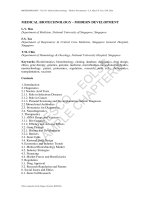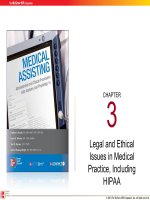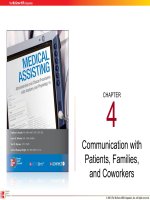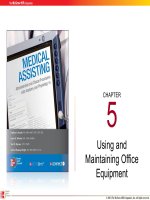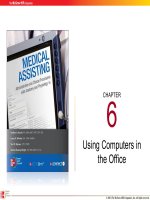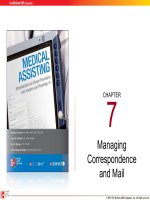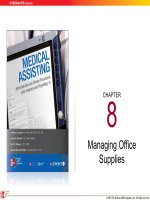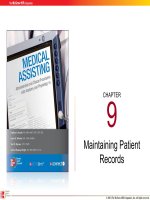Lecture Medical biotechnology
Bạn đang xem bản rút gọn của tài liệu. Xem và tải ngay bản đầy đủ của tài liệu tại đây (3.37 MB, 94 trang )
Medical biotechnology
including diverse discipline dedicated to improving human health
Drug production (use for treatment of infectious,
cardiovascular diseases…)
Diagnostics (determine or identify a possible disease or disorder)
Gene therapy (use of DNA as a pharmaceutical agent
to treat disease)
Pharmacogenomics (influence of genetic variation
on drug response in patients by correlating gene expression
or SNP with a drug's efficacy or toxicity)
Diagnostics and gene therapy
It mostly focuses on:
Disease prevention
Disease diagnosis,
Disease treatment.
A disease is a condition that impairs normal bodily functioning. Examples of diseases include:
heart disease, cancer, diabetes, HIV/AIDS, inherited diseases,…
Pharmaceutical industry
The Food and Drug Administration (FDA) is a US regulatory agency
that oversees food, drugs and devices. It also monitors clinical trials and
approves new drugs that have succeeded.
Pharmaceutical companies are those licensed to discover, develop,
market, and distribute drugs.
Drugs (according to the FDA) are defined as substances intended for use in
diagnosis, cure, treatment, or prevention of disease.
Drug Production
1.
Screening: is a laborious and costly process—only 1 in every 5,000 to 10,000 compounds screened eventually becomes an approved drug.
To screen an antibiotic, it is first placed in a bacterial culture. If the antibiotic is effective, it is next tested on infected laboratory animals to study the
safety and efficacy of the new drug.
2. Selecting: A new drug is selected for testing on humans only if it either promises to have therapeutic advantages over drugs already in use or is safer.
3. Clinical investigations, or "trials," of the drug on human patients. First: a small group of healthy volunteers to determine and adjust dosage levels, and
monitor for side effects.
Second: a larger group of volunteers or carefully selected patients.
Third round: a very large panel, sometimes upwards of 10,000 individuals.
4.
Approval of The U.S. Food and Drug Administration's (FDA), and Center for Drug Evaluation and Research (CDER) for commercial use.
The entire process, from the first discovery of a new compound to FDA approval, can take over a decade and cost hundreds of millions of dollars.
Preclinical Testing
The first step is to identify a potential drug candidate, called a lead
compound.
Once a lead compound has been identified in the lab, it begins years of
testing to evaluate its safety and efficacy.
In vitro studies are carried out to identify the way it interacts with its
target.
After that, tests on model organisms (animals that have the targeted disease) take
place. This usually lasts around 6-7 years.
Preclinical Testing
Many preclinical tests include pharmacokinetics - the study of
how drugs move through living organisms.
Four processes are examined in pharmacokinetic studies:
absorption, distribution, metabolism & excretion.
Investigational New Drug (IND) Application
After preclinical testing is completed, a company files an IND application with the Food &
Drug Administration (FDA) prior to any testing on humans.
This application includes:
•
Results of preclinical studies
•
Chemical structure & properties
•
Pharmacokinetics
•
Side effects
•
Clinical trial plan
Clinical Trials
Clinical trials are a process of testing products prior to approval of a drug
or treatment plan for widespread use in humans.
• Begin after the use of model organisms
• Most are classified into 3 phases: I, II, & III
• All participants go through informed consent process (given facts
about risks & benefits)
Phase I
• Initial studies of drug in a small number (20 -80) of healthy volunteers to
determine its safety
• Intended to determine safe dose range
• Exceptions are made for highly toxic treatments (ex. cancer or HIV) - in this
case appropriate patients selected
•Pharmacokinetic studies determine dosing & limitations of use
Take 6 months - 1 year to complete
Phase II
• Larger groups of people with the disease (100 - 300) are used to study
efficacy
• Safety is further evaluated
• Side effects also studied
• Optimal dose strength and schedule (once or twice daily)
• Dose-response relationship evaluated to visualize drug performance
Usually about 2 years to complete
Phase III
• Medicine is tested in large, randomized, controlled trials with larger numbers
(1000 - 5000) of patient volunteers using blind & double blind studies
• Continued evaluation of efficacy & identification of side effects (adverse
events)
• Efficacy compared to the “standard” treatments for disease
• Many times an outpatient setting, so patient compliance is important
Can take 1-4 years.
New Drug Application (NDA)
• If findings from clinical trials prove safe and effective, then company files
new drug application (NDA) with FDA
• Data must support that drug is more effective than placebo (a substance
with no pharma-cological effect) or drug offers alternative to existing
medication
• About 80% of drugs that make it to Phase III studies get approved.
Phase IV/
Ongoing studies
• Even after a product is on the market, studies & safety monitoring continue
• FDA requires periodic reports including cases of adverse events
• Phase IV studies (post-marketing) evaluate long-term safety, how it affects particular
groups (elderly/children), & comparisons with established treatments
Continues for years
Occasionally, new indication (intended use for drug) may be found.
Drug development process
Pharming: recombinant drug production
Pharming (farming and pharmaceutical ) refers to the useful pharmaceuticals that are product of exogenous
genes transfered into host animals or plants that would not express those genes.
Recombinant pharmaceuticals :
Large quantity,
Purified,
Eating (plants) or drinking the milk
Recombinant pharmaceuticals
Number (and percentage values) of recom-binant proteins approved as biopharma-
Accumulated number of recombinant biopharmaceuticals obtained in
ceuticals in different production systems.
different production systems.
/>
Medical biotechnology
including diverse discipline dedicated to improving human health
Gene therapy (use of DNA as a pharmaceutical agent
to treat disease)
Gene transfer vectors (retrovirus, lentivirus, adeno
associates virus, adeno virus, plasmid like virus,…)
Gene therapy trials in the world
Gene therapy trials in the world
Gene therapy trials in the world
Gene therapy trials in the world
Applications
live vaccines
induce strong immune responses
kill or modify specific cells
vaccine
TIBTECH, 1998, 16: 230
Strategy for recovery of positive strand RNA viruses from cloned sequences
TRENDS IN MIROBIOLOGY, 1996, 4: 387
Virus Vector Technologies
•
•
•
•
Refined vector systems,
Improved production methods,
Enhanced transduction rates,
Greater vector–host safety profiles.
Four main technical barriers to successful gene therapy
1.
2.
3.
4.
Vector uptake, transport and uncoating (cell surface receptors).
Vector genome persistence (site-specific integration).
Sustained transcriptional expression (specific promoter, silencing).
The host immune response (to capsid components and transgene products).
The barriers to successful gene therapy
Nature Rev Genet, 2011, 12:315

